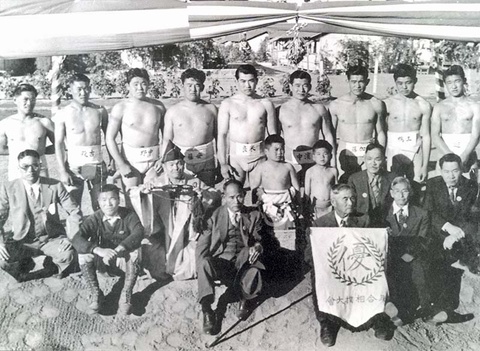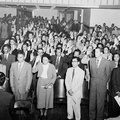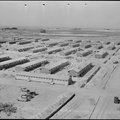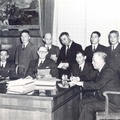Read Part 1 >>
Japanese American Sumo in the New Era: From Issei to Nisei
The 1924 Immigration Act was an important turning point in the history of Japanese Americans. With the termination of new Japanese immigration and the exodus of many Issei, the population of first generation immigrants decreased rapidly, and the average age of the Nikkei drastically changed. By 1930, the second generation made up more than 50 percent of the entire Japanese American population. While the majority of Nisei were in their early teens or younger, most Issei males were already in their late forties or above. Given the legal discrimination that the first generation faced, the Nikkei society increasingly became Nisei-oriented, since the U.S. born generation presumably enjoyed the same rights and privileges as other American citizens. Issei parents now devoted themselves to preparing for the coming Nisei era.

Sumo wrestlers from Sacramento, ca. late 1920s. They are carrying the championship flag presented by the Japan Sumo Association. Gift of Ray R. Mori. Japanese American National Museum (97.17.1).
Japanese American sumo underwent a transformation as well. By the late 1920s, the majority of wrestlers were second-generation Japanese Americans. Sumo came to be seen as a means of Nisei education. Issei parents believed that sumo helped their American-born children to acquire mental toughness and physical strength, along with a particular Japanese spirit.
The Issei, rejected by the United States, took pride in their native land. After World War I, Japan had become one of the major powers in the world. The Issei found it encouraging that Japan, despite its late entry into modernity, had achieved major-power status in the international arena, because they believed it proved that the Japanese were as good as Westerners. By the same token, they believed that Nisei, with their American citizenship, would be able to excel in American society—if they successfully maintained the Japanese heritage that made Japan so strong. The Issei also felt that their children could reduce the friction between Japan and the United States by acting as a bridge of peace and understanding. For these goals to be realized, it was imperative that the second generation fully understand and appreciate Japan and its culture. The rising popularity of traditional Japanese sports—sumo, kendo, and judo—among the Nisei in the 1930s reflected these strong expectations of their Issei parents.
In order to facilitate Nisei education through sumo, Issei sumo leaders formed central organizations. The American Sumo Association was established in Los Angeles in 1925, and the Central Northern California Youth Sumo League in Sacramento two years after. (In 1937, the latter split into two leagues—one in Fresno and the other in Sacramento.) Each of these organizations sponsored regional sumo tournaments two or three times a year, while jointly holding a state-wide tournament once a year. In total, they had approximately 1,000 members.
These sumo organization also maintained close relationships with the Sumo Association in Japan. Beginning in 1927, in response to requests from the Issei, the Japan Sumo Association sent several professional sumo masters, who trained Nisei youths all over California. It also presented an official championship flag, for which Japanese American wrestlers competed in the state-wide tournaments. In 1936, a Sacramento Issei was issued a referee license (gyoji) and was allowed to call himself “Kimura”—a prestigious name that only the official gyoji can use in the sumo world. Finally, a few Nisei were recruited to compete in professional Japanese sumo.
The dispatch of a Japanese American sumo kengakudan (study tour) to Japan in 1937 symbolized both the progress of Nisei education via sumo and the deepening interest in Japan. Ten Nisei, primarily from the Los Angeles area, toured Japan for more than two months, learning about their parents’ homeland and demonstrating to the Japanese people how competitive Japanese American sumo had become.
Despite these signs of the progress of sumo on the mainland, it is doubtful if the average Nisei shared the Issei’s views. Not many Nisei appreciated the martial spirit of Japan that their parents wanted them to acquire. Many young people preferred to play American sports, such as baseball and basketball. To them, Japan was as foreign and exotic as it was to other Americans. Some Nisei recall that many second-generation youths participated in sumo not so much because they loved it as because their parents and neighbors strongly urged (or forced) them to do so. Although they conceded to the parental pressure, they often felt so awkward about exposing their bodies that they wore shorts under their mawashi.
Kibei (Nisei born in the United States and educated in Japan) tended to be more receptive to the Issei’s expectations and to the Japanese sport. Many of the best second-generation sumo wrestlers were Kibei. Some of them had experienced sumo while they were in Japan; others enjoyed the opportunity to mingle with other Kibei, since they were often isolated from each other and from English-speaking Nisei. The popularity of sumo in California’s Central Valley is probably because the region had many Kibei working in the fields during the 1930s. For them, just as for the Issei, sumo offered a sense of belonging.
The End of Japanese American Sumo
The Pacific War effectively ended Japanese American sumo on the mainland. Anything associated with the Japanese became the target of persecution, which prompted many Japanese Americans to reject their ethnic heritage. Sumo, too, was rejected by many Issei and Nisei, because it came to represent the war-like nature of Imperial Japan. With the mass removal of 110,000 Issei and Nisei from the West Coast, the sport was on its way to oblivion in Japanese America.
Despite the difficult circumstances, there were some who continued the tradition in concentration camps. Issei sumo leaders, who were quickly arrested by the FBI after Pearl Harbor and subsequently sent to Justice Department camps, enjoyed wrestling as they had two or three decades before.
In Merced Assembly Center, where many people from the Sacramento area were imprisoned before moving to permanent camps, a group of Issei organized a sumo tournament in which a few dozen Nisei participated. Although the Sacramento group ceased to play sumo after being separated into several different camps, enthusiastic wrestlers from Southern California and Fresno held an inter-camp tournament between Poston and Gila River in 1945. Although most immigrant sumo leaders eventually chose to be repatriated to Japan, a few remaining Issei and Nisei strove to keep sumo alive in the postwar Nikkei communities.

Inter-camp sumo tournament at Gila River, Arizona, ca. 1944. Gift of the late Harry Shigemori Tanaka Family. Japanese American National Museum (97.37.1).
Along with the persistent fear of being identified with Japan, a wave of redevelopment in the early 1950s gave the final death blow to Japanese American sumo. The sumo ring in Sacramento was demolished after the last tournament in 1952, and Little Tokyo lost its ring on North San Pedro Street with the construction of the Los Angeles Police Department building. Without financial resources or community support, postwar sumo leaders could not build new rings to continue the tradition. Today, Japanese American sumo has been almost completely forgotten.
Note: There is little published material about sumo in the Japanese American communities. The following publications are the best available resources.
- Marvin K. Opler. “A Sumo’ Tournament at Tule Lake Center,” American Anthropologist 47:I (Jan-Mar. 1945): 134-39.
- Japanese language: Chaplin Matsunomori. Hawai’i Sumokai o kataru. [An Account of Sumo in Hawai’i]. Honolulu, 1957.
- Kato Shin’ichi, ed. Beikoku Nikkeijin Hyakunenshi [Hundred-year History of the Japanese American]. San Francisco, 1961.
- Zaibei Nihonjinkai. Zabei Nihonjinkai [History of the Japanese in America]. San Francisco, 1940.
*This article was originally published in the Japanese American National Museum Quarterly, Fall 1997.
© 1997 Japanese American National Museum






